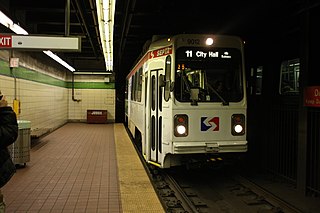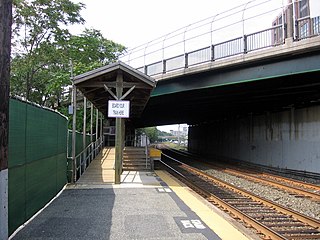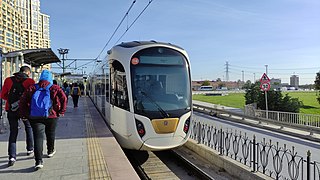
A tram is a type of urban rail transit consisting of either individual railcars or self-propelled multiple unit trains that run on tramway tracks on urban public streets; some include segments on segregated right-of-way. The tramlines or tram networks operated as public transport are called tramways or simply trams/streetcars. Due to their close similarities, trams are commonly included in the wider term light rail, which also includes systems separated from other traffic.

The Toronto Transit Commission (TTC) is the public transport agency that operates bus, subway, streetcar, and paratransit services in Toronto, Ontario, Canada, some of which run into Peel Region and York Region. It is the oldest and largest of the urban transit service providers in the Greater Toronto Area, with numerous connections to systems serving its surrounding municipalities.

Light rail is a form of passenger urban rail transit using rolling stock derived from tram technology while also having some features from heavy rapid transit.

The Light Rail, also known as the Light Rail Transit (LRT), officially the North-West Railway, is a light rail system in Hong Kong, serving the northwestern New Territories, within Tuen Mun District and Yuen Long District. The system operates over 1,435 mmstandard gauge track, using 750 V DC overhead power supply. It was once one of four systems comprising the KCR network in Hong Kong, before the MTR–KCR merger in 2007. It has a daily ridership of about 483,000 people. The line is colour warm yellow on the map, formerly deep orange before the MTR–KCR merger.

The Toronto streetcar system is a network of eleven streetcar routes in Toronto, Ontario, Canada, operated by the Toronto Transit Commission (TTC). It is the third busiest light-rail system in North America. The network is concentrated primarily in Downtown Toronto and in proximity to the city's waterfront. Much of the streetcar route network dates from the 19th century. Three streetcar routes operate in their own right-of-way, one in a partial right-of-way, and six operate on street trackage shared with vehicular traffic with streetcars stopping on demand at frequent stops like buses. Since 2019, the network has used low-floor streetcars, making it fully accessible.
Various terms are used for passenger railway lines and equipment; the usage of these terms differs substantially between areas:

The SEPTA subway–surface trolley lines are a collection of five SEPTA trolley lines that operate on street-level tracks in West Philadelphia and Delaware County, Pennsylvania, and also underneath Market Street in Philadelphia's Center City. The lines, Routes 10, 11, 13, 34, and 36, collectively operate on about 39.6 miles (63.7 km) of route.

The 512 St. Clair is an east–west streetcar route in Toronto, Ontario, Canada, operated by the Toronto Transit Commission (TTC). It operates on St. Clair Avenue between St. Clair station on the Line 1 Yonge–University subway and Gunns Road, just west of Keele Street.

The Siemens S70 and its successor, the Siemens S700, are a series of articulated low-floor light-rail vehicles (LRV) and modern streetcars manufactured for the United States market by Siemens Mobility, a division of German conglomerate Siemens AG. The series also includes a European tram-train variant, the Siemens Avanto.

The Canadian Light Rail Vehicle (CLRV) and Articulated Light Rail Vehicle (ALRV) were types of streetcars used by the Toronto Transit Commission (TTC) from the late 1970s until the late 2010s. They were built following the TTC's decision to retain streetcar services in the 1970s, replacing the existing PCC streetcar fleet.

The Baltimore Light RailLink is a light rail system serving Baltimore, Maryland, United States, and its northern and southern suburbs. It is operated by the Maryland Transit Administration. In downtown Baltimore, it uses city streets. Outside the central portions of the city, the line is built on private rights-of-way, mostly from the defunct Northern Central Railway, Baltimore and Annapolis Railroad and Washington, Baltimore and Annapolis Electric Railway. The system had a ridership of 3,546,300, or about 13,700 per weekday, as of the second quarter of 2024.

A street running train is a train which runs on a track built on public streets. The rails are embedded in the roadway, and the train shares the street with other users, such as pedestrians, cars and cyclists, thus often being referred to as running in mixed traffic. Tram and light rail systems frequently run on streets, with light rail lines typically separated from other traffic.

Light rail is a commonly used mode of public transit in North America. The term light rail was coined in 1972 by the Urban Mass Transportation Administration to describe new streetcar transformations which were taking place in Europe and the United States. The Germans used the term Stadtbahn, which is the predecessor to North American light rail, to describe the concept, and many in UMTA wanted to adopt the direct translation, which is city rail. However, in its reports, UMTA finally adopted the term light rail instead.

Railway platform height is the built height – above top of rail (ATR) – of passenger platforms at stations. A connected term is train floor height, which refers to the ATR height of the floor of rail vehicles. Worldwide, there are many, frequently incompatible, standards for platform heights and train floor heights. Where raised platforms are in use, train widths must also be compatible, in order to avoid both large gaps between platforms and trains and mechanical interference liable to cause equipment damage.

The Flexity Outlook is the latest model of streetcar in the rolling stock of the Toronto streetcar system owned by the Toronto Transit Commission (TTC). Based on the Bombardier Flexity, they were first ordered in 2009 and were built by Bombardier Transportation in Thunder Bay and Kingston, Ontario, with specific modifications for Toronto, such as unidirectional operation and the ability to operate on the unique broad Toronto gauge.

The Istanbul Tram is a modern tram system on the European side of Istanbul. The first section, the T1 opened in 1992, followed by the T2, which opened in 2006. In 2011, the T1 and T2 merged, with the line retaining the T1 name. The T4, T5 and the T6 lines followed, opening in 2007, 2021 and 2024 respectively.

High-floor describes the interior flooring of commuter vehicles primarily used in public transport such as trains, light rail cars and other rail vehicles, along with buses and trolleybuses. Interior floor height is generally measured above the street surface or above the top of the rail. High-floor designs usually result from packaging requirements: mechanical items such as axles, motors, crankshafts, and/or transmissions, or luggage storage spaces are traditionally placed under the interior floor of these vehicles. The term is used in contrast with low-floor designs, which offer a decreased floor and entry height above the street surface. Since low-floor designs generally were developed after high-floor vehicles, the older high-floor design is sometimes also known as conventional or the “traditional” design.

The Alstom Flexity is a family of trams, streetcars, and light rail vehicles manufactured by Bombardier Transportation, since 2021 a division of French company Alstom. As of 2015, more than 3,500 Flexity vehicles are in operation around the world in Europe, Asia, Oceania, and North America in 100 cities among 20 countries internationally. Production of the vehicles is done at Bombardier's global production plants and by local manufacturers worldwide through technology transfer agreements.

Toronto-gauge railways are tram and rapid transit lines built to Toronto gauge, a broad gauge of 4 ft 10+7⁄8 in. This is 2+3⁄8 in (60 mm) wider than standard gauge of 4 ft 8+1⁄2 in which is by far the most common track gauge in Canada. The gauge is unique to the Greater Toronto Area and is currently used on the Toronto streetcar system and the Toronto subway, both operated by the Toronto Transit Commission. Several now-defunct interurban rail systems also once used this gauge. The Halton County Radial Railway, a transport museum is located on one of the former interurban lines and uses the Toronto gauge.
























